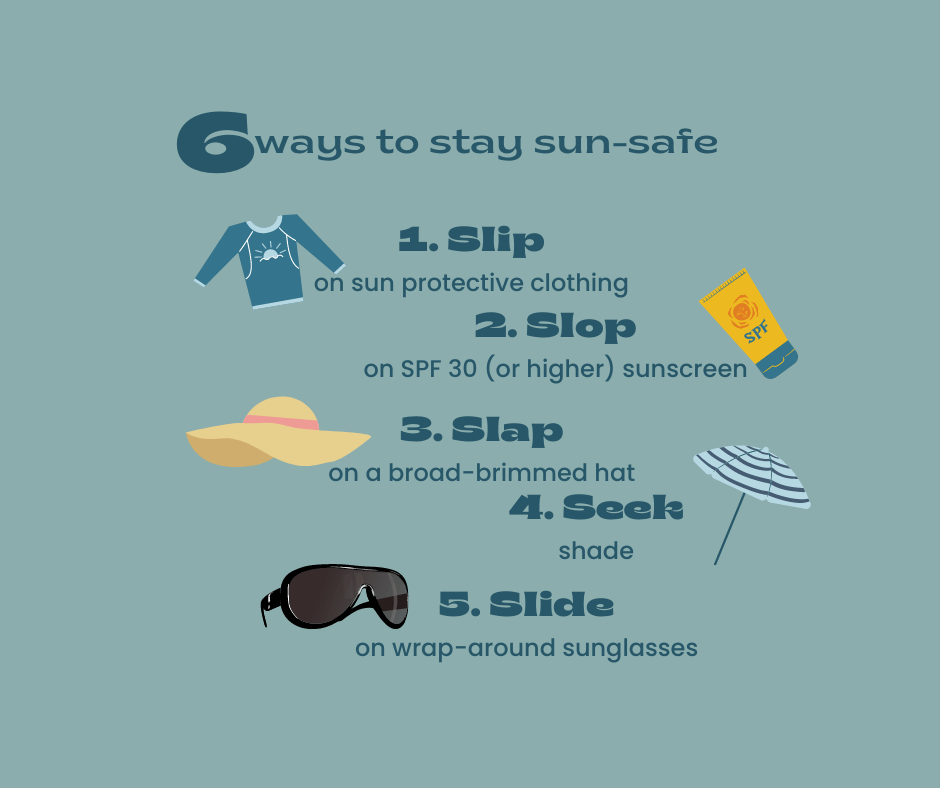Melanoma March
In the past couple of months at least 8 people that I know have had to have suspicious spots on their skin removed and have had those biopsies sent away for testing.
Some of these people are under 57, others over 60 years of age, one man in particular had a spot-on top of his head, he kept delaying seeing the doctor. Once he finally did, the doctor told him that if he left it another week it would’ve gone into his brain. What a horrifying thought!
Yet, when we go to the beach each weekend, I can’t help but notice how people are not sitting under an umbrella but out in the hot sun, many with toddlers running around just with swimmers and no hat. Are they not setting their toddlers up for future melanoma?
Melanoma is the most deadly form of skin cancer. It develops in the skin’s pigment cells, known as melanocytes, and can spread via the blood and lymphatic system to distant organs like the lungs, liver and brain. - Melanoma Institute Australia
Melanoma facts: -
Melanoma is often referred to as ‘Australia’s national cancer’.
16 800 Australians will be diagnosed with melanoma this year.
Melanoma kills 1 Australian every 6 hours.
1 Australian id diagnosed with melanoma every 30 minutes.
It is estimated 1 300 Australians will die from melanoma this year.
Melanoma is the third most common cancer in Australia.
Melanoma is the most common cancer affecting 20- to 39-year-old Australians.
Melanoma is the second most common cancer in Australian men, after prostate cancer.
Melanoma is the third most common cancer in Australian women, after breast and colorectal cancer.
95% of melanomas are caused by overexposure to UV radiation from the sun.
If caught early, 90% of melanomas can be cured by surgery.
How does melanoma form?
Melanoma develops in the body’s pigment cells, known as melanocytes.
When the skin is exposed to sunlight, melanocytes produce melanin to help protect the skin from ultraviolet (UV). ‘When these cells cluster together in the skin during childhood or adolescence, they form a mole’.
When abnormal melanocytes grow in an uncontrolled way, the evade the immune system.
A ⅓ of all melatonin starts from an existing mole but can develop anywhere on the skin.
Left untreated, it can grow very quickly and spread to the dermis (lower part of the skin) and can enter the lymphatic system or bloodstream, spreading to other parts of the body like the brain (as mentioned before), liver, lunges or bone. - Melanoma Institute Australia
‘Melanoma signs and symptoms
Often melanoma has no symptoms, however, the first sign is generally a change in an existing mole or the appearance of a new spot. These changes can include:
colour - a mole may change in colour, have different colour shades or become blotchy
size - a mole may appear to get bigger
shape - a mole may have an irregular shape, may increase in height or not be symmetrical
elevation - the mole may develop a raised area
itching or bleeding.
Other symptoms include dark areas under nails or on membranes lining the mouth, vagina or anus.
New moles and spots will appear and change during childhood, adolescence and during pregnancy and this is normal. However, adults who develop new spots or moles should have them examined by their doctor.’ - Cancer Council
What causes melanoma?
‘Over exposure to UV radiation causes 95% of melanomas. Melanoma risk is increased for people who have:
unprotected sun exposure
a history of tanning and sunburn, especially during childhood and adolescence
lots of moles
atypical moles
already had a skin cancer, including basal cell carcinoma (BCC) or squamous cell carcinoma (SCC)
fair skin, red hair, blue eyes or skin that burns easily
a family history of melanoma, especially if they developed it at a young age (i.e. less than 40)
certain genetic variations that can be inherited in families.’ - Melanoma Institue Australia
Who is at risk?
Anyone can develop melanoma. The risk is higher for people who have:
• unprotected exposure to UV radiation when the UV index is 3 or above, particularly a pattern of short, intense periods of sun exposure and sunburn, such as on weekends and holidays
• lots of moles (naevi), especially if the moles have an irregular shape and uneven colour
• pale or freckled skin, especially if it burns easily and doesn’t tan
• fair or red hair, and blue or green eyes
• a previous melanoma or other type of skin cancer
• a strong family history of melanoma (see below)
• a weakened immune system from using immunosuppressive medicines for a long time.
To find out how melanoma spreads, click here.
For other skin cancers, click here.
What is UV?
Ultraviolet (UV) radiation
‘Think UV, not heat!
UV is an invisible source of radiation that cannot be seen or felt.
Unlike visible light which we see and infrared radiation which we feel as heat, UV can damage our skin without us realising.
Even on cool or cloudy days, UV radiation can be strong enough to damage unprotected skin and eyes.
Sun protection is generally required when the UV Index reaches 3 and above. However, because UV damage accumulates over time, it is recommended that outdoor workers, or those working near highly reflective surfaces, use sun protection year-round, even when the UV Index is below 3. UV levels vary according to your location in Australia. You can access daily sun protection times and UV levels for your location:
• in the weather section of the newspaper
• using the free SunSmart app for your smart phone or tablet
• downloading the SunSmart widget for websites - sunsmart.com.au/widget
• online at: Bureau of Meteorology - bom.gov.au/uv ARPANSA - arpansa.gov.au MyUV - myuv.com.au UV Daily - uvdaily.com.au
Be SunSmart with the free SunSmart app available at the App Store and Google Play.’
To find out about the main types of melanomas, click here.
‘Diagnosis of melanoma
Melanoma can vary in the way it looks.
The first sign is usually a new spot or change in an existing mole.
Physical examination
If you do notice any changes to your skin, your doctor will examine you and carefully check any spots you have identified as changed. Your doctor will use a handheld magnifying instrument (dermascope) and consider the criteria known as “ABCDEFG”. Further tests may be carried out by your GP such as total body photography, or you may be referred to a specialist (dermatologist).
A - Asymmetry - Are the halves of each spot different?
B - Border - Are the edges uneven, scalloped or notched?
C - Colour - Are there differing shades and colour patches?
D - Diameter - Is the spot greater than 6 mm across, or is it smaller than 6 mm but growing larger?
E - Elevated - Is it raised?
F - Firm - Is it firm to touch?
G - Growing - Is it growing quickly?
To view the above in images, click here.
Biopsy
If the doctor suspects that a spot on your skin could be melanoma, an excision biopsy is carried out with the removal of the whole spot.
This will then be examined under a microscope by a specialist to see if there are any cancer cells.
Checking lymph nodes
Your doctor may feel the lymph nodes near the melanoma to see if they are enlarged as melanoma can sometimes travel via the lymph vessels to other parts of your body. Your doctor may also recommend a biopsy to take a sample of the cells from an enlarged lymph node for further examination under a microscope.
If the doctor suspects melanoma, a biopsy may be carried out. This may be done by your GP or you may be referred to another specialist.
After a diagnosis of melanoma
After being diagnosed with melanoma, you may feel shocked, upset, anxious or confused. These are normal responses. A diagnosis of melanoma affects each person differently. For most it will be a difficult time, however some people manage to continue with their normal daily activities.
You may find it helpful to talk about your treatment options with your doctors, family and friends. Ask questions and seek as much information as you feel you need. It is up to you as to how involved you want to be in making decisions about your treatment.
Find out more about the best melanoma care, click here.
‘Treatment for melanoma
Staging
Test results will show whether you have melanoma and if it has spread to other parts of the body. The melanoma will be given a stage of 0-4, usually written in Roman numerals. The most important feature of a melanoma in predicting its outcome is its thickness.
stage 0 is less than 0.1mm
stage I less than 2mm
stage II greater than 2mm
stage III spread to lymph nodes and stage IV spread to distant skin and/or other parts of the body.
The presence of ulceration also predicts a poor outcome. If distant spread is suspected, CT scans of the chest, abdomen and pelvis are performed. The blood test LDH can sometimes be useful to assess metastatic disease.
Early-stage melanoma
Surgery (wide local excision) can be curative for thin melanomas and requires that the melanoma be removed as well as more normal-looking skin around the melanoma (usually between 5mm and 10mm).
Many people with early melanoma don’t need to have lymph nodes removed. However, in some cases, you may have a sentinel lymph node biopsy which removes the first lymph node the melanoma may have spread to.
The removal of the lymph nodes can cause side effects such as swelling in your neck, armpit or groin. This is called lymphoedema.
If there is a risk that the melanoma could come back, you may be offered additional treatments. These can include immunotherapy and targeted therapy.
Advanced melanoma
Treatment for advanced melanoma, where the cancer has spread to lymph nodes, internal organs or bones, may include surgery, radiation therapy targeted therapy or immunotherapy.
Surgery may be used to treat metastatic melanoma that involves other parts of the skin. Surgery may also still be possible if the melanoma has spread to other organs but will depend on the part of the body that is affected.
Radiation therapy may be of benefit in treating some forms of melanoma. It may be used:
when cancer has spread to the lymph nodes
after surgery to prevent the cancer returning
in combination with other treatments
as palliative treatment.
Targeted therapy drugs attack specific genetic changes (mutations) that allow melanomas to grow and spread while minimising harm to healthy cells. It is most commonly used for melanomas that have spread to other organs or if it has come back after treatment.
Immunotherapy uses drugs to stimulate the body's immune system in order to recognise and fight melanoma cancer cells. Ipilimumab, nivolumab and pembrolizumab are three immunotherapy drugs approved for treatment of advanced melanoma.
‘Screening for melanoma
National targeted melanoma screening program is step closer
A national targeted melanoma screening program is a step closer following today’s release of the ‘Skin Checks for Melanoma in Australia Position Statement’, led by Melanoma Institute Australia in collaboration with expert colleagues from across the country.
To read more above ‘Skin Checks for Melanoma in Australia Position Statement’ click here.
However, individuals at high risk of melanoma should be taught to check their skin for irregular or changing lesions, and have annual checks by a dermatologist.
Click here to download Cancer Council’s skin cancer identification poster to help identify potential skin cancers.
Preventing melanoma
‘Avoid sunburn by minimising sun exposure when the UV Index is 3 or above, and especially in the middle of the day when UV levels are most intense. Seek shade, wear a hat that covers the head, neck and ears, wear sun protective clothing and close-fitting sunglasses, and wear an SPF30 sunscreen. Avoid using solariums.
Work outdoors? Use UV protection every day - Download the PDF here.’ - Cancer Council
How to protect your skin.
Sun protection should be implemented in your workplace according to the hierarchy of control measures.
Aim to reduce exposure to UV radiation where you can, before solely relying on personal protective equipment (PPE) to protect your skin.
Whether enjoying the outdoors or working outdoors Cancer Council recommends these five simple steps to protect against UV radiation damage.
01 - Slip on sun-protective clothing.
Use clothing to cover as much skin as possible.
Working outside?
Wear long pants and work shirts with a collar and long sleeves are best. Choose darker coloured, lightweight, closely woven material with an ultraviolet protection factor (UPF) 50+. Choose loose fitting clothing to keep cool in the heat.
02 - Slop on SPF 30 or higher broad-spectrum, water resistant sunscreen.
Sunscreen does not provide complete protection so never rely on sunscreen alone.
Apply sunscreen generously to clean, dry skin 20 minutes before you go outdoors. Apply 1 teaspoon of sunscreen per limb and another teaspoon for the face, ears and neck.
Set reminders to reapply every two hours or more often if sweating or working with water.
Protect your lips with an SPF 30 or higher lip balm.
Always check and follow the use by date on sunscreen.
Sunscreen should be stored in a cool dry place (below 30 degrees and not in the car glovebox)
.
A hat should shade your face, ears and neck. Wear a broad brimmed, bucket style or legionnaire hat.
If wearing a hard hat or helmet, use a brim attachment or legionnaire style flap attachment.
Baseball caps are not recommended as they do not protect the face, head, ears or neck – the most common areas for skin cancer to occur.
04 - Seek shade.
Make use of trees or built shade or bring your own.
Work and take breaks in the shade. Where no shade exists, use temporary portable shade.
Plan to work indoors or in the shade during the middle of the day when UV radiation levels are strongest.
Plan to do outdoor work tasks early in the morning or later in the afternoon when UV radiation levels are lower.
Share outdoor tasks and rotate staff so the same person is not always out in the sun.
Choose shade that has extensive overhead and side cover and is positioned away from highly reflective surfaces.
05 - Slide on some sunglasses.
Protect the eyes at all times when outdoors during daylight hours.
When buying new sunglasses, check the swing tag to ensure they meet the Australian Standard (AS/ NZS 1067:2016 – category 2, 3 or 4). Category 4 is not safe for driving.
Look for an eye protection factor (EPF) 10.
Safety glasses that meet AS/NZS 1337:2012 still provide sun protection.
How do you know what the UV index is at any given point?
06 - Switch
Switch on the SunSmart Global UV app click here for more info.
There you have it. Whether you are out gardening, going for a walk or to the beach, remember we don’t see UV rays. Protect yourself and your loved ones, today for tomorrow. The choice is ours to make.





